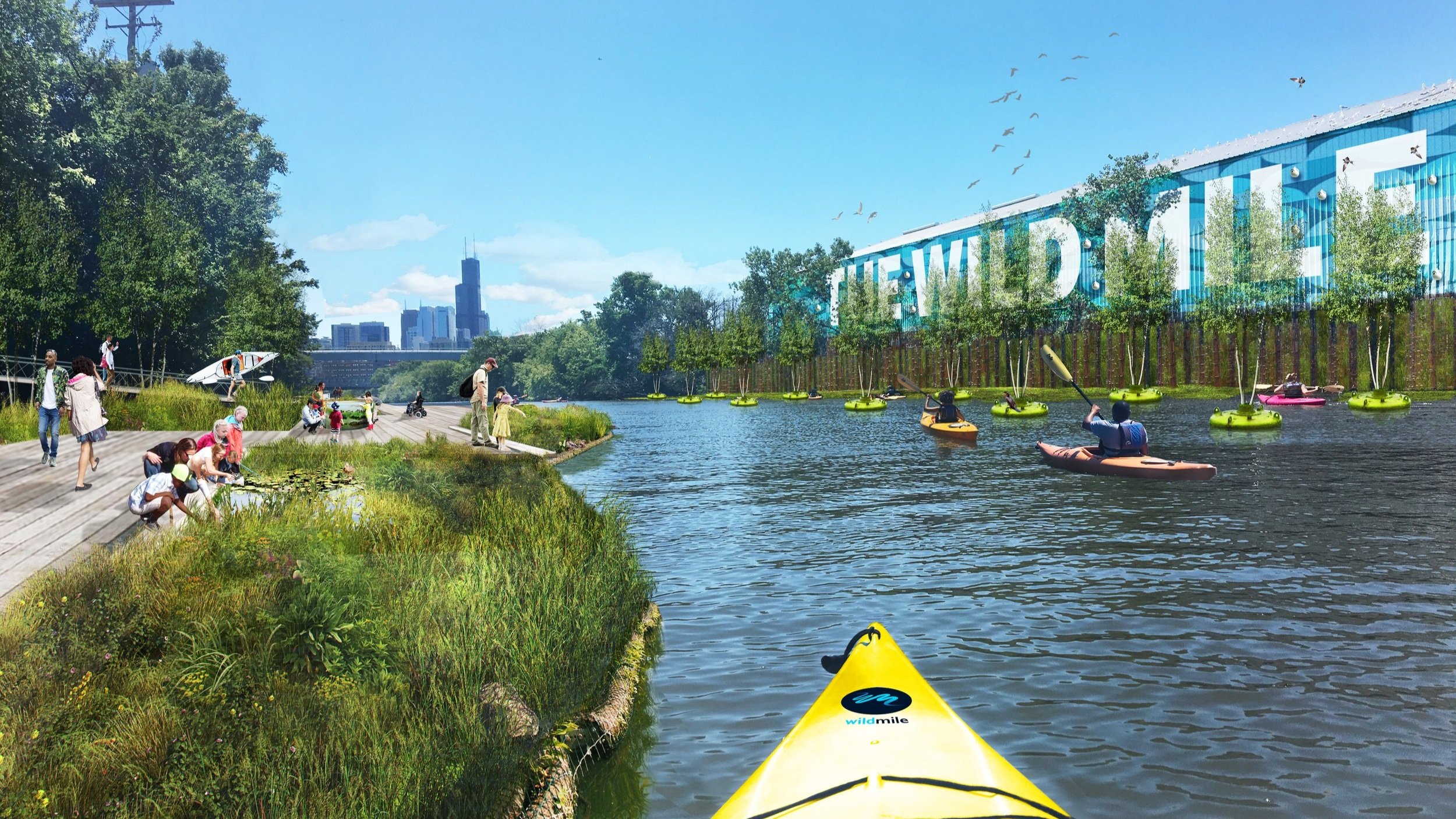
Who?
The Wild Mile is a collaborative endeavor, led by Urban Rivers along with a coalition of partners including the City of Chicago, Shedd aquarium, the Near North Unity Program, Neighborspace and many more. This flagship project is dedicated to transforming urban waterways into vibrant wildlife sanctuaries, showcasing the power of partnership in creating sustainable urban spaces.
What?
The Wild Mile takes a wildlife-first approach to public greenspace. Combining ADA-accessible boardwalks with floating artificial habitats, the Wild Mile remains open to the public 24-7, and is used as a space for recreation, education, research, community gatherings, and more.
The habitats mimic a natural wetland ecosystem - one that might have been found in the Chicago area long before the city was developed. They are pontoon-based, made of environmentally friendly materials, and built to last. Populated by wetland species native to Illinois, the gardens allow plant roots to grow through the physical framework, directly into the river.
The root system provides important habitat for young fish and other small river species. It also serves as giant water filter, as wetland plants are known to sequester pollutants such as heavy metals. These plants also help regulate the natural phosphorous and nitrogen cycles as the seasons change.
In addition to garden-like modules, certain portions of the Wild Mile are submerged, and feature underwater habitat intended to mimic a natural river floor. Here, Urban Rivers runs restoration projects for endangered freshwater mussels, which are no longer able to survive in urban stretches of river due to the unfavorable conditions of the post-industrial river floor. These mussels play a crucial role in the local ecosystem, and filter up to ten gallons of water per day!
Anchored to both the river floor and the seawall, the Wild Mile can move up and down as the water level changes. The Wild Mile has stayed put through dramatic flooding, even when the river has risen above the seawalls. Most urban waterways have been engineered very similarly to the Chicago River, so the Wild Mile’s design is applicable to cities woldwide.
When?
Urban Rivers hosts events, volunteer opportunities, and tours of the Wild Mile year-round, with the mission of helping Chicago’s diverse communities connect with their local waterway.
Events
Workshops, Wild Mile Walking Tours, kayaking, and more! All Urban Rivers events are free and open to the public.
Click here to see what we have scheduled.
Volunteering
From invasive species removal to trash cleanup via kayak, we need your help to make the river better, and keep the Wild Mile looking great!
Click here to learn more about our volunteer opportunities.
Host a Program
The Wild Mile is a space developed by and for the community - it’s a constant collaboration. If you’re interested in bringing your community down to the river by hosting an event or program on the Wild Mile, click here to send us an email!
Where?
Come enjoy the world’s first floating eco-park!
Located along the North Branch Canal of the Chicago River, the Wild Mile can be enjoyed by foot or boat.
Head to 905 West Eastman Street behind REI to access the Wile Mile boardwalk. Walk amongst the floating gardens or launch from our public access dock. Kayak and see the river the way it is meant to be enjoyed.
Come visit the first section of the floating boardwalk by car, bike, or CTA.
Why?
In 1853, William Ogden (Chicago’s first mayor) purchased the land currently known as Goose Island and began digging a canal east of the river. For most of Chicago’s history, this canal was used as an industrial corridor, hosting the barges and other vessels that carried lumber, coal, grains, and more.
Over time, the area transitioned from industrial to commercial, and later, commercial to residential. Though no longer used for industry, the surrounding waterways still feature infrastructure designed for boats rather than humans or wildlife - 20-foot seawalls, minimal access points, and layers of polluted industrial residue on the river floor. In recent years, city entities, community groups, and nonprofits alike have realized the potential held by the river as a recreational and ecological resource.
The Goal
The goal of the Wild Mile Chicago Framework Plan is to create a new environment for (1) habitat, (2) recreation, and (3) education.
The community’s input and feedback is vital to creating new access to the river, educational and recreational opportunities, in addition to the implementation of ecology and habitat.
The North Branch Framework, which was produced in partnership with the community and was approved by the Chicago Plan Commission in 2017, envisioned a 17-acre in-stream river park as one of the defining features for the modernization of the North Branch Industrial Corridor. In 2018-2019 The City of Chicago commissioned Urban Rivers along with partners such as Omni Ecosystems, Skidmore, Owings, and Merrill (SOM), and Near North Unity Program, & Neighborspace to create the Wild Mile Framework Plan. This plan, which you can download below, was outlined over the course of many community meetings and builds on the vision of a renewed urban ecology for the city of Chicago. With the goal of generating cleaner, healthier water and more vibrant wildlife ecosystems, the Wild Mile was designed to fit within the isolating industrial infrastructure, bridging the gap between humans and nature.
Since 2017, the City of Chicago has committed 3.2 million dollars towards the installation of the first two segments of the Wild Mile, which is currently 400 linear feet long and will stand at approximately 700 linear feet come spring of 2024.
Highlights from the framework plan:
How?
The Wild Mile is a “living laboratory” - an ongoing experiment and a constant collaboration between its caretakers, designers, and the community it serves. It wouldn’t be possible without people like YOU! Get in touch with us to share your ideas for collaboration!














